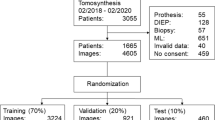Abstract
Mammographic breast density has been established as an independent risk marker for developing breast cancer. Breast density assessment is a routine clinical need in breast cancer screening and current standard is using the Breast Imaging and Reporting Data System (BI-RADS) criteria including four qualitative categories (i.e., fatty, scattered density, heterogeneously dense, or extremely dense). In each mammogram examination, a breast is typically imaged with two different views, i.e., the mediolateral oblique (MLO) view and cranial caudal (CC) view. The BI-RADS-based breast density assessment is a qualitative process made by visual observation of both the MLO and CC views by radiologists, where there is a notable inter- and intra-reader variability. In order to maintain consistency and accuracy in BI-RADS-based breast density assessment, gaining understanding on radiologists’ reading behaviors will be educational. In this study, we proposed to leverage the newly emerged deep learning approach to investigate how the MLO and CC view images of a mammogram examination may have been clinically used by radiologists in coming up with a BI-RADS density category. We implemented a convolutional neural network (CNN)-based deep learning model, aimed at distinguishing the breast density categories using a large (15,415 images) set of real-world clinical mammogram images. Our results showed that the classification of density categories (in terms of area under the receiver operating characteristic curve) using MLO view images is significantly higher than that using the CC view. This indicates that most likely it is the MLO view that the radiologists have predominately used to determine the breast density BI-RADS categories. Our study holds a potential to further interpret radiologists’ reading characteristics, enhance personalized clinical training to radiologists, and ultimately reduce reader variations in breast density assessment.



Similar content being viewed by others
References
Obenauer S, Hermann KP, Grabbe E: Applications and literature review of the BI-RADS classification. Eur Radiol 15:1027–1036, 2005
Laboratory for Individualized Breast Radiodensity Assessment (LIBRA), available online: https://www.cbica.upenn.edu/sbia/software/LIBRA/index.html. Accessed date: August 1, 2016
Quantra, available online: http://www.hologic.com/en/breast-screening/volumetric-assessment/
Volpara, available online: http://www.volparadensity.com/
Huo CW, Chew GL, Britt KL et al.: Mammographic density—a review on the current understanding of its association with breast cancer. Breast Cancer Res Treat 144:479–502, 2014
Berg WA, Campassi C, Langenberg P, Sexton MJ: Breast imaging reporting and data system: inter-and intraobserver variability in feature analysis and final assessment. Am J Roentgenol 174(6):1769–1777, 2000
Shin H-C, Roth HR, Gao M, Lu L, Xu Z, Nogues I, Yao J, Mollura DJ, Summers RM: Deep convolutional neural networks for computer-aided detection: CNN architectures, dataset characteristics and transfer learning. IEEE Trans Med Imaging 35(5):1285–1298, 2016
Y. Bar, I. Diamant, L. Wolf, S. Lieberman, E. Konen, and H. Greenspan. Chest pathology detection using deep learning with non-medical training. In 2015 I.E. 12th International Symposium on Biomedical Imaging (ISBI), pages 294–297. IEEE, 2015.
B. van Ginneken, A. A. Setio, C. Jacobs, and F. Ciompi. Off-the-shelf convolutional neural network features for pulmonary nodule detection in computed tomography scans. In 2015 I.E. 12th International Symposium on Biomedical Imaging (ISBI), pages 286–289. IEEE, 2015.
Miao S, Wang ZJ, Liao R: A CNN regression approach for real-time 2D/3D registration. IEEE Trans Med Imag 35(5):1352–1363, May 2016
Cheng, Jie-Zhi et al. Computer-aided diagnosis with deep learning architecture: applications to breast lesions in US images and pulmonary nodules in CT scans. Scientific Reports 6 (2016): 24454. PMC. Web. 25 Apr. 2017.
Kallenberg M et al.: Unsupervised deep learning applied to breast density segmentation and mammographic risk scoring. IEEE Trans Med Imag 35(5):1322–1331, 2016
LeCun Y, Bengio Y, Hinton G: Deep learning. Nature 521:436–444, 2015
Caffe, available online: https://github.com/BVLC/caffe/tree/master/models
Keller BM, Nathan DL, Wang Y, Zheng Y, Gee JC, Conant EF, Kontos D: Estimation of breast percent density in raw and processed full field digital mammography images via adaptive fuzzy c-means clustering and support vector machine segmentation. Med Phys 39(8):4903–4917, 2012
Metz CE: ROC methodology in radiologic imaging. Invest Radiol. 21(9):720–733, 1986 Sep
DeLong ER, DeLong DM, Clarke-Pearson DL: Comparing the areas under two or more correlated receiver operating characteristic curves: a nonparametric approach. Biometrics:837–845, 1988
Breast density notification legislation, available online: http://densebreast-info.org/legislation.aspx
Acknowledgements
This work was supported by a National Institutes of Health (NIH)/National Cancer Institute (NCI) R01 grant (#1R01CA193603), a Radiological Society of North America (RSNA) Research Scholar Grant (#RSCH1530), a Precision Medicine Pilot Award (#MR2014-77613) from the University of Pittsburgh Cancer Institute-Institute for Precision Medicine, and a Biomedical Modeling Pilot Award from the Clinical and Translational Science Institute of the University of Pittsburgh. We gratefully acknowledge the support of NVIDIA Corporation with the donation of the Titan X Pascal graphics processing unit (GPU) used for this research. We thank Brenda F. Kurland for the helpful discussion related to this work.
Author information
Authors and Affiliations
Corresponding author
Ethics declarations
Conflict of Interest
The authors declare that they have no conflicts of interest.
Rights and permissions
About this article
Cite this article
Mohamed, A.A., Luo, Y., Peng, H. et al. Understanding Clinical Mammographic Breast Density Assessment: a Deep Learning Perspective. J Digit Imaging 31, 387–392 (2018). https://doi.org/10.1007/s10278-017-0022-2
Published:
Issue Date:
DOI: https://doi.org/10.1007/s10278-017-0022-2




